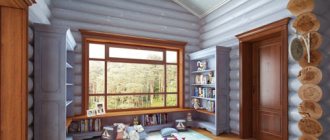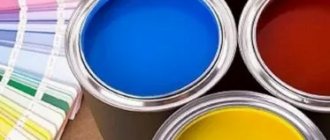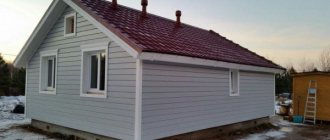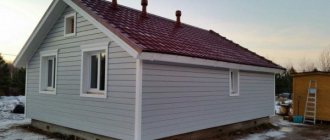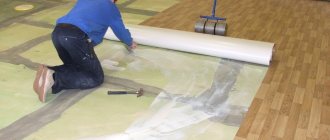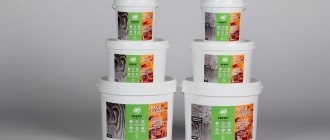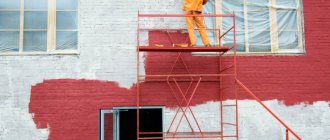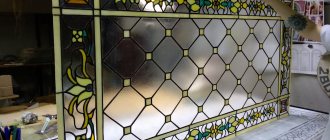Wood is a living material, so processes occur in it that are characteristic of all living organisms. Under the influence of time and unfavorable weather factors (rain, sun, temperature changes), wood begins to age, become sick and deteriorate. Various microorganisms and insects that settle in the tree and gradually destroy its structure, as well as mold and mildew that form in damp places, also contribute to this negative process. As a result, the wood loses its original appearance, and the house turns into an unsightly gray structure. Painting the gray walls of a wooden house can solve the problem. How to renew aged wood, and what paint is best to paint it with, that’s what we’ll talk about.
How to properly prepare wood for painting?
Even if the material for the construction of the log house was purchased and already treated with antiseptics, it is recommended to repeat the procedure before final painting.
The reason is that many antiseptic compounds used in production are so-called transport ones and have a validity period of six months to a year. That is, their protection is quite enough for the time the house is being built, but not enough to continue to provide decent protection.
It is also mandatory to apply fire retardants to increase the fire resistance of wood. In some cases, it is possible to use dual-use compounds - fire-retardant drugs.
It should also be remembered that in addition to the façade and premises, a wooden house has other elements that require appropriate protection. We are talking about rafters, joists, frames, beams and other structures hidden from view. As a rule, they are treated with persistent antiseptics, and given that they are little susceptible to negative influences, this is quite enough for long-term and reliable protection.
Special treatment is required for the end parts of timber or logs, which have greater moisture absorption capacity and are also prone to cracking.
To do this, you can use the same compositions as for the main surface, but only apply them more thoroughly and in a large number of layers, for example, 2-3. Neglecting the protection of the ends, even if a log or beam is protected over the entire surface, makes it vulnerable, especially to various parasitic microorganisms.
In addition, high-quality processing of the ends allows you to reduce the consumption of the base composition used for painting, since the surface will absorb less paint or varnish. And since the cost of these materials is more expensive than antiseptic ones, this will reduce the cost of painting the house as a whole.
If the surface shows signs of blue discoloration or signs of mold or mildew infection, a thorough cleaning should be carried out using special bleaching compounds with an antiseptic effect.
Selection of paints and varnishes for painting walls
If you plan to paint the outside of a wooden house with your own hands, you should definitely understand some rules for choosing paint and varnish compositions for this. Should be considered:
- climatic conditions in which operation will take place. The labeling on the packaging must contain information about which natural factors a particular composition is resistant to;
- for which walls: internal or external it is intended;
- features of the architectural style or interior design (in this case, great importance is attached to such criteria as color and degree of concealment or transparency);
- toxicity, both at work and during operation.
It is also important to pay attention to the density of the composition and its ability to spread, since both the quality of application and the consumption of material depend on this criterion
In addition to being guided by the data contained in the instructions, it should be taken into account that different surfaces have different absorbent abilities, therefore the consumption may differ from the recommended one. Often lighter paint colors have a higher consumption, since in order to achieve an even, beautiful color, an additional layer is required.
To reduce consumption, and therefore reduce the cost of painting the walls of a wooden house, you should choose the color of the base base to match the base paint.
But the most important thing is to always adhere to the rule of applying the coloring composition exclusively to a dry, prepared surface, otherwise even the best paint will not last its entire life.
Enamels
This material deserves special attention, since in some countries it is not isolated separately, but is sold as paint. However, the differences are quite large, which makes it possible to expand the scope of such substances.
The fact is that enamels create very durable surface films that can withstand even serious mechanical stress. In this case, the coating is perfectly smooth and, in most cases, glossy. Therefore, craftsmen, when advising how to paint the outside of a wooden house, often lean towards this particular material, especially if the surface has certain defects or putty areas.
Types of paints and their characteristics
Paints are designed to preserve wood and create a top protective layer.
Mandatory characteristics of outdoor paints must meet the following parameters:
- No moisture absorption.
- Frost resistance, i.e. the ability to withstand cycles of freezing and thawing.
- Availability of a UV filter. Protecting wood from sunlight, which causes the effect of overheating of natural material, which leads to loss of appearance.
- Antiseptic properties and bioprotection.
- Resistant to abrasion and mechanical stress.
As a rule, all manufacturers declare the presence of the listed properties in ready-made recipes. But in reality there is a rapid loss of performance under real-world operating conditions.
The paint of the facade differs from that used as part of the base. Based on this, it is customary to classify its three types:
- acrylic;
- alkyd;
- oil
In Europe, acrylic grades have long become the quality standard. 80% of home owners, especially in the northern regions, choose this type of paint. It is believed that the base of water and acrylates is the safest, from an environmental point of view, and does not harm people.
The main advantages are the absence of a pronounced pungent odor, the presence of a breathable texture, and hardness. Acrylic coatings do not clog the pores of wood and at the same time protect well from water absorption and easily tolerate frost.
They come in a wide range of colors, blend easily to your desired shade, and won't fade or fade for years. Thorough cleaning of the surface is not required before use. One of the disadvantages is the ban on storing acrylates in sub-zero temperatures. In the cold, such paint deteriorates irrevocably.
Alkyd-based exterior wood paint went on sale much earlier than its acrylic counterparts. They cost less, so they are constantly in demand. They dry on average for 8-12 hours, but the coating is not as durable as in the case of acrylates. The resin composition does not penetrate deep into the wood, but hardens on the surface in the form of a film.
This adhesion is sufficient to repel moisture, heat resistance up to 90 degrees and frost resistance up to -30 degrees. However, the conditions for preserving such a paint layer cannot be long (up to 7 years).
Alkyd bases are used mainly for small areas of structures - doors, window frames, thresholds, decorative elements, which are maximally protected from external influences.
An undoubted disadvantage is the whim of alkyds. In order for the coating to harden without bubbles and burrs, it is necessary to work exclusively on a completely dried surface.
Modern people use the least demanding oil paints. They are mainly found in the lines of domestic brands; they are almost completely absent abroad.
The main ingredient of the mixtures is linseed oil - a toxic, odorous substance. The smell disappears in a few days. At the same time, the raw materials are expensive, which makes the resulting paints not very cheap. The color scales are poor and do not suit the tastes of many. The paint almost does not allow the wood to breathe, which leads to the formation of cracks over time. White paint is popular.
Even application is even more difficult than with alkyd paints. Oil paint on wood is applied only to completely cleaned surfaces or previous layers of oil. It is incompatible with other types of paints.
Interior wood paints will leak, even with careful preparation. It takes at least 24 hours to dry. Requires painting in 2-3 layers. Be sure to carry out work in dry weather. Service life less than 5 years.
Odorless paints
It is advisable to paint residential premises with quick-drying, odorless compounds. Residents spend a lot of time here, so the finishing solution should consist of environmentally friendly raw materials and not emit harmful fumes. Painting of furniture, decorative elements and other wooden products that are constantly located inside the house should also be carried out with water-based compositions that are safe for health.
Acrylic
This is the most modern type of paint. Acrylic compositions are highly expensive, they are made from environmentally friendly raw materials, and when applied they form an elastic film.
The pigment solvent in acrylic paints is water, so they do not emit harmful substances into the atmosphere. The high price of the material in question is justified by improved technical characteristics. The film is resistant to moisture, sudden temperature changes and ultraviolet radiation. Despite the frost resistance of the coating, the finished paint should not be stored at subzero temperatures.
Acrylic paint for wood is considered one of the highest quality materials. The coating retains its structure and color for 8 years.
Application of paint and varnish products to the prepared base can be carried out in various ways: with a paint brush, roller or spray gun. The solution penetrates deeply into the wood structure and dries quickly. The starting composition mixes well with various pigments, which allows you to obtain a coating of the desired shade. The acrylate composition protects wooden products from moisture while still being breathable.
Latex
Many consumers believe that a better effect can be achieved by coating wooden products with oil paint, but this solution has a characteristic odor, so it is better to use it for painting the facade of a residential building or in outbuildings. Instead of oil paints, you can use water-based latex paints, which will create the same effect as oil paints. The difference between latex paint and acrylic paint is the presence of rubber substances in the composition, which add elasticity to the dried surface.
The latex solution penetrates deeply into the wood structure, does not form streaks when applied, and creates a water-permeable layer on the surface. Despite the presence of water in the composition, dirt on the latex surface can be cleaned with a damp sponge.
The main advantage of the dye in question is the ability to breathe. This means that wooden walls painted with latex paint will allow water vapor to pass through the structure of the material well. A favorable microclimate is established in the house. The main disadvantage of the composition is the possibility of cracks appearing on the surface under the influence of negative temperatures, so the solution is recommended for use inside heated rooms.
Polyvinyl acetate (PVA)
Polyvinyl acetate compounds are considered in demand among consumers due to their low cost. This solution is used for interior decoration of walls and ceilings, consists of natural materials, and can be applied to wood bases, plaster or cardboard. The base solution can be diluted with any color, which allows you to obtain the desired color. After applying the composition, the user receives a beautiful matte or glossy surface. Another advantage of polyvinyl acetate paint is its rapid drying.
The disadvantages include the inability to paint metal products and the destruction of the coating under the influence of moisture. Therefore, the paint is not suitable for facade work; it cannot be used in wet areas.
The consumption of the composition depends on its color. To cover 1 m2 of usable area you need 250 grams of light-colored dye or 150 grams of a dark-colored substance. This is due to the fact that the first composition must be applied in two layers.
When the sheer volume of work stops you
The market offers a wide variety of paint and varnish products, both in color and in the main binder material
And the situation with wooden exterior structures of a house is constantly deteriorating from the very moment they were installed, because wood is far from being a material that will successfully withstand for a long time:
- constant exposure to sunlight;
- exposure to low, sometimes very low, temperatures;
- temperature changes;
- periodic and very intense influence, not even of moisture, but of direct flows of water;
- exposure to wind load;
- constant challenge from dust and debris blown by the wind;
- exposure to microflora and insects;
- when it comes to a building, the impact of the structure itself.
The photo shows the final sanding of the entire rough wooden surface, followed by the fight against cracks
Primary requirements
Based on these factors, special requirements are imposed on the wood of the house, which will simplify its maintenance in the future:
it must be of the highest quality;
- it must be perfectly dried;
- it must be treated with antiseptic drugs.
Solving the question of how to properly paint the outside of a wooden house necessarily begins with the question of what tools to choose
Paint selection
For painting a wooden facade, we have four options to choose from:
Oil paints. These attract everyone with their fame, accessibility, wide range of colors and price. Oil paints are produced on the basis of drying oil, which ensures deep penetration of paint into the structure of wood and, thus, its good protection. But at the same time, such paints lose color quite quickly and will take several hours to dry, so you need to carefully consider when to carry out the work so that atmospheric conditions do not affect the quality of the coating.
The final finishing coat of paint is always applied in two layers - the first one is thicker
- Acrylate paints. The best choice among all currently possible offers. Even after application, such paints allow the surface to “breathe” freely; they do not interfere with air exchange. They retain their viscosity even after hardening, so they do not crack. They do not lose their color even 5-6 years after application.
- Covering antiseptic or alkyd-acrylate paints. This type of material appeared among manufacturers’ proposals not so long ago. Most importantly, such paints help to significantly improve the appearance of wood (although you should not skimp on it under this sauce), and they last for at least 10 years without losing both the appearance and the quality of surface protection.
- Varnishes and azures. These materials are in no way inferior to paints in their protective qualities, but they allow you to leave the texture of the used wood samples visible.
The choice of what paint to paint the outside of an old wooden house also depends on its overall design - such greenery on the windowsill requires utmost attention to the protective properties of the paint
Due to the large number of proposals, it is advisable to classify paints according to their cost.
Here the grouping is in three categories:
- economy class with a cost of no more than 100 rubles per kilogram; These include domestic paint brands “Texturol”, “Aquatex”, “Senezh”;
- middle class – from 100 to 300 rubles/kg; here are the most famous representatives of Tikkurila and Belinka;
- premium – cost above 300 rub/kg; This price range includes offers from Johnestones, Dulux, Woodworks.
The instructions require that you first carefully prepare the entire surface for work with your own hands - remove all old paint first.
Material calculation
Before purchasing paints and varnishes, you need to calculate the required amount of product. For ease of understanding, an example of a calculation is given based on varnishing prepared parquet.
For a room with a floor area of 15 square meters, therefore, you will need
- water-based varnish 15 x (100…120) = 1500…1800 g or
- alkyd varnish 15 x 80 = 1200 g.
Calculations will be greatly simplified using special calculators.
The amount of primer, stain, impregnation and other things is calculated in the same way
When making calculations, it is important to reserve at least 10% for unforeseen circumstances or possible problems with some of the materials
Useful tips
It is best to paint a new wooden house with antiseptics. If the wood is of expensive species, you should give preference to glazing compounds; if the house is made of logs of ordinary species, coating compounds can hide some of its shortcomings. They can only be applied at positive temperatures, in sunny weather. The antiseptic will be able to penetrate deeply into the structure of the wood, provided that it is well dried.
If the house has already been painted and its facade only needs to be updated, there is only one recommendation for choosing paint - it is better to use the type of paint that has already been used previously. You can determine it by the appearance of the old coating. If it has a grainy texture similar to that of real leather, the house has most likely been previously painted with acrylic paint.
To determine the type of old coating, you need to make a cut somewhere in an inconspicuous place with a knife. When the paint cracks as a result, the house was most likely previously painted with oil-based paint. When worn, the painted surface becomes mesh-like. In such a situation, it is better to completely remove all the old layers of coating and only then apply a new one. When the coating is rolled into a tube, it is acrylate paint.
Stages of processing a new house
At the preparatory stage of work, wooden logs or boards are cleaned of dust, and also get rid of mold and blue stains. After this, you need to sand the base. When treating wooden walls of a new building, it is necessary to apply an antiseptic or a selected primer to the surface. After the layer has dried, begin painting the material with the chosen paint.
The composition is applied with a roller or brush, and the movements of the painting tool should be along the fibers. Experienced builders can use a sponge to paint the surface. Using this material, various abstract patterns are created. To apply the composition evenly, it is advisable to use a spray gun.
If there is a need to “refresh” a previously painted house, then the amount of work carried out increases. First you need to remove peeling sections of the film, clean the surface of debris, and grind. After this, the walls are wiped with a dampened sponge or washed under high pressure water.
It is better to remove the old layer of paint with special scrapers, a brush or a metal spatula. In some cases, it is advisable to use a hair dryer or a special composition that will help remove peeling paint. After cleaning the surface, you can begin applying a new composition.
Video description
In the video, a specialist talks about what you need to pay attention to when choosing paint for a wooden house:
If necessary, you can apply oil or alkyd paint over the glaze layer of antiseptic. If you purchased an acrylic composition for painting the facade, you will have to remove the antiseptic film right down to the wood.
Based on cost, paints are divided into three classes. Budget materials are produced by Senezh. Their products cost no more than one hundred rubles per kilogram of paints. The middle price segment is represented by the brands “Belinka” and “Tikkurila”. Their products on average across the country are estimated at 200-300 rubles per kilogram. The most expensive paints cost from 350 rubles and above. In the premium segment there are products from, Woodworks and Johnestones.
If the surface of the paint cracks like a mesh, most likely the house was painted with oil paintSource akspic.ru
Young fighter course
We're going to focus on unconventional painting methods. However, it's worth starting with the basics.
How to paint various surfaces correctly?
Without a clear understanding of this, it is difficult to know which deviations from standard procedure are acceptable and which should be avoided.
- All old paint and varnish coatings are stripped down to a solid base.
Please note: the base must be stronger than the coating. Violation of this simple rule most often leads to paint peeling.
- The surface is cleaned of all kinds of contaminants, dust, rust and degreased..
- Then the surface to be painted is primed . Primers have greater adhesion to substrates and provide more reliable adhesion between them and paint.
- Finally, the dye itself is applied - usually in several very thin layers . If necessary, thickened paint is diluted with an appropriate solvent: two or three thin layers dry faster and are more durable than one thick one.
In addition, it is worth paying attention to several nuances.
- Coatings adhere better to rough substrates. If the surface is glossy, it is first subjected to rough grinding. Smooth metals are often etched before painting.
Phosphating primer VL-02 transforms the metal surface to improve its adhesive properties.
- Excessive absorbency of the surface to be painted leads to unnecessary waste of dye. Before painting in such cases, the use of penetrating primers is justified. They fill the largest pores, at the same time binding the top layer of the base and increasing its strength.
Now let's move on to difficult situations and exceptions to the rules.
How to paint a facade correctly
To make the appearance of a wooden house look respectable, it is not enough to choose the right paint. It still needs to be correctly applied to the front side of the residential building. To do this, experts recommend pre-cleaning all surfaces, removing dust and dirt. This can be done with a rag and brush. If, as a result of cleaning, areas with fungal infection are discovered, they must be treated with special chemical compounds. Gaps and cracks are sealed with wood putty. There is an assortment of high-quality compositions. Metal elements present on the facade are primed.
To paint your house well, you need:
- apply paint in two layers;
- the second is applied when the first is completely dry;
- Before use, the paint must be thoroughly mixed; the use of a non-uniform composition will cause uneven coloring of the wood;
- Before applying, it is useful to test the paint color on a small area of the surface somewhere at the back of the house;
- It is better to paint with oil, acrylate and acrylic paints in dry, cloudy weather;
- this should not be done when direct rays of the sun fall on the house, when it is raining or a strong wind is blowing;
- The ends of the house should be worked out more carefully than the steep surfaces themselves, this will help prevent cracking.
Generalization on the topic
Many people associate a wooden house with homely warmth and comfort. Wood is a warm, environmentally friendly material. Such buildings can last a long time if they are properly cared for. Painting the facade of a building will not only transform its appearance, but also protect it from the harmful effects of direct sunlight, sedimentary moisture, temperature changes, insects and rodents. The article provides recommendations from specialists that will help significantly facilitate the solution of the identified problem.
Facade painting technology
Painting a wooden surface may seem like a fairly simple task, but in reality it is absolutely not.
There is a technology that is very important to follow; it includes several stages and depends on whether the painting of an old house will be carried out or a new structure
For proper distribution of pigment, it is important to periodically stir the paint while working. Uniform application is achieved only if the brush is correctly selected and its size. The brightness can be controlled by the amount of pigment added. It is not recommended to carry out work during lunchtime under the sun, as the paint will dry out very quickly. Antiseptics should be applied in a longitudinal direction. The ends of the logs must be treated with a primer before painting. This will prevent significant paint absorption
In addition, this treatment will protect the wood from rotting.
What tools should you choose to treat the external surface of your home?
You can do all the work yourself
In order for the whole process to go much faster and better, it is important to first prepare all the necessary tools:
brushes (it is important to choose the right size); roller; container for paint; gloves to protect hands; masking tape to protect glass and other elements.
Painting a new house
You don’t need any special skills to paint the surface, but you should follow some recommendations that will allow you to get a better result. To protect the surface from fungus and mold, it is worth applying several layers of antiseptic before painting.
Paint should only be applied to a dry surface. To achieve the best appearance, several coats must be applied. Each new layer is applied only after the first has dried.
Painting a new home is a pleasure. There is no need to carry out any special preparatory work. The paint is applied to the surface using a brush. Paint should be applied only in the longitudinal direction.
How to paint an old wooden house
Before painting the facade of an old house, it is necessary to carry out a number of preparatory work. First you need to remove the old coating
It is important to paint the surface with the same composition as before. Otherwise, the paint will stick much worse
To remove old paint from the surface, use a wire brush. If mold is detected, all areas must be treated with a special antiseptic and completely dried. Otherwise, the fungus will begin to appear again. If individual elements are completely rotten, they need to be replaced with new ones.
Before applying any paint to an old surface, it is recommended to perform priming work. This will significantly increase the adhesion between materials. And the paint will have an attractive appearance for a longer period.
Rust
Is there any way to avoid completely removing the rust? Cleaning curved surfaces with your own hands, given their large area, is extremely tedious.
Solution
A rust converter will come to the rescue - a composition that chemically converts iron oxides into a durable insoluble coating. The price of a liter package is approximately 200 rubles.
Rust converter.
Technology
- Plate rust is removed with a spatula. The converter can change its chemical composition, but will not do anything with its spatial structure; the base for painting, as we remember, must be durable.
- Areas stained with lubricating oils or solarium are degreased with a solvent.
- The rust converter is applied with a sponge or brush. Painting is possible immediately after it has dried.
Natural appearance and savings
Have you always dreamed of building a real wooden house? Unfortunately, such a pleasure is not available to everyone these days, because wood is a valuable and expensive material. It is much easier and cheaper to get the same natural appearance using dark log siding, which has many advantages:
- Thanks to modern developments, this material looks very much like wood, and its service life is much longer.
- It does not require careful additional care.
- Log siding is much more resistant to aggressive environmental conditions in our country.
- It is perfectly protected from pests that you may encounter while using the tree.
There is a misconception that if you choose and install dark siding instead of wood, your home will not “breathe.” In fact, this is not the case, because the panels are well ventilated using a ventilated facade system. With this system, air can circulate freely between the wall and the cladding. If necessary, you can lay another layer of insulation between them, which will make your home more comfortable and warmer in the winter.
The dark siding in the photo looks just great. From the first time it is simply impossible to distinguish it from natural wood. Positive reviews also speak only about the advantages of this material.
Probably the only drawback of dark siding is that over time it can fade in the sun and lose its presentable appearance. To prevent this from happening, initially purchase high-quality material from well-known manufacturers. Siding of dark colors must be treated with special substances that repel the sun's rays and help maintain color saturation for a longer time. If your siding fades very quickly in the sun, then this can only mean one thing - low quality material.
To take or not to take? The choice is yours!
If you still can’t decide on the choice of materials for building your house, then look at the dark siding in the photos of houses. In the photographs you can see the excellent and presentable appearance of houses in which siding was used. You simply cannot find more modern, high-quality and at the same time cheaper material.
The main advantages of dark siding over other materials can be noted:
- long service life - up to 25 years;
- maximum naturalness;
- resistance to adverse weather conditions;
- reliability;
- protection against ultraviolet radiation and rotting;
- ease of installation.
The choice is yours, but if there is an opportunity to make the finish as natural as possible and at the same time inexpensive, then you simply should not refuse this opportunity. There are a huge number of home design options, the main thing is to show your imagination, and then your home will truly be original and memorable.
